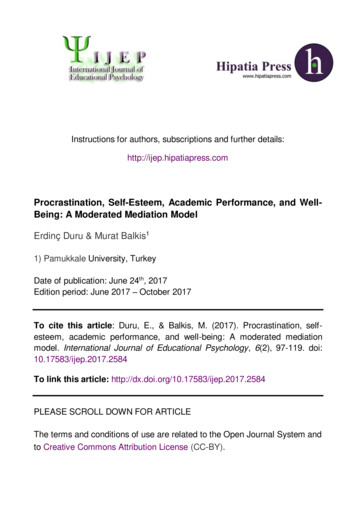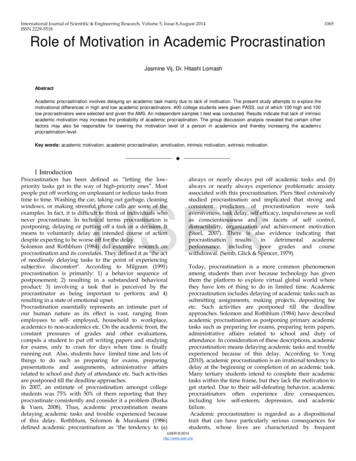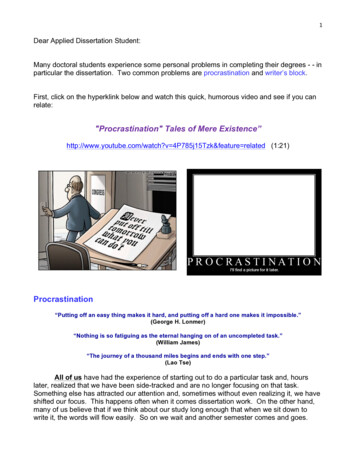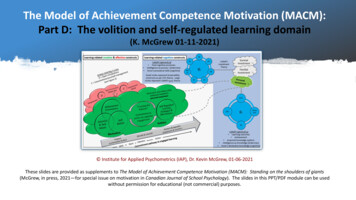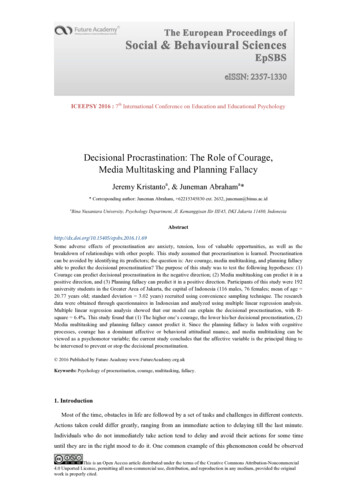
Transcription
ICEEPSY 2016 : 7th International Conference on Education and Educational PsychologyDecisional Procrastination: The Role of Courage,Media Multitasking and Planning FallacyJeremy Kristantoa, & Juneman Abrahama** Corresponding author: Juneman Abraham, 62215345830 ext. 2632, juneman@binus.ac.idaBina Nusantara University, Psychology Department, Jl. Kemanggisan Ilir III/45, DKI Jakarta 11480, 2016.11.69Some adverse effects of procrastination are anxiety, tension, loss of valuable opportunities, as well as thebreakdown of relationships with other people. This study assumed that procrastination is learned. Procrastinationcan be avoided by identifying its predictors; the question is: Are courage, media multitasking, and planning fallacyable to predict the decisional procrastination? The purpose of this study was to test the following hypotheses: (1)Courage can predict decisional procrastination in the negative direction; (2) Media multitasking can predict it in apositive direction, and (3) Planning fallacy can predict it in a positive direction. Participants of this study were 192university students in the Greater Area of Jakarta, the capital of Indonesia (116 males, 76 females; mean of age 20.77 years old; standard deviation 3.02 years) recruited using convenience sampling technique. The researchdata were obtained through questionnaires in Indonesian and analyzed using multiple linear regression analysis.Multiple linear regression analysis showed that our model can explain the decisional procrastination, with Rsquare 6.4%. This study found that (1) The higher one’s courage, the lower his/her decisional procrastination, (2)Media multitasking and planning fallacy cannot predict it. Since the planning fallacy is laden with cognitiveprocesses, courage has a dominant affective or behavioral attitudinal nuance, and media multitasking can beviewed as a psychomotor variable; the current study concludes that the affective variable is the principal thing tobe intervened to prevent or stop the decisional procrastination. 2016 Published by Future Academy www.FutureAcademy.org.ukKeywords: Psychology of procrastination, courage, multitasking, fallacy.1. IntroductionMost of the time, obstacles in life are followed by a set of tasks and challenges in different contexts.Actions taken could differ greatly, ranging from an immediate action to delaying till the last minute.Individuals who do not immediately take action tend to delay and avoid their actions for some timeuntil they are in the right mood to do it. One common example of this phenomenon could be observedThis is an Open Access article distributed under the terms of the Creative Commons Attribution-Noncommercial4.0 Unported License, permitting all non-commercial use, distribution, and reproduction in any medium, provided the originalwork is properly cited.
eISSN: 2357-1330Selection & Peer-review under responsibility of the Conference Organization Committeeby looking at the behavior of student X. Student X was given an assignment from his lecturer that gavehim a three-week deadline. Because of the long duration, he didn’t even touch and read any of theassignment. Then, in the next two weeks and five days, he was asked by his friends to help about theirassignment and he was panicked, because he had forgotten all about it, and thus, pulled an all-nighter tocomplete the whole assignment. This phenomenon is called procrastination and was based oninterviews conducted by the author with some university students.Stead, Shanahan, and Neufeld (2010) described procrastination as a delay of an action. Take anexample of student X’s behavior above, in which he chose to delay his assignment, and when thedeadline neared, panic struck. Perhaps this example of behavior doesn’t really describe procrastinationas a whole. In the task completion process, individuals may delay and avoid an assignment, due to theirset of priorities, or perhaps they need some sorts of break to release some stress. There are two types ofdelays; some people delay to avoid the undesired outcome and some delay for no strong reason. Thepositive delay is done to avoid the impulsive decision-making, and the negative delay is caused by noapparent reason (Ferrari, as cited in in Orellana-Damacela, Tindale, & Suarez-Balcazar, 2000).Therefore, there are two types of procrastination; functional and dysfunctional. Functionalprocrastination is the delay of task completion to find more compatible and suitable information, so thatthe task results can be perfect. On the other hand, dysfunctional procrastination is the delay of taskcompletion with no clear purpose and direction. Dysfunctional procrastination is a form of unrelatedactivity, which is not relevant in the context of the work. There are two forms of dysfunctionalprocrastination, which are decisional procrastination and behavioral-avoidant procrastination (Ferrari &Emmons, 1995). Decisional procrastination is a form of cognitive thinking that delays the decisionmaking of an assignment in order to face stressful situations, thus reducing the pressure in the mind todeal with other situations (Pychyl, Morin, & Salmon, 2000), while behavioral avoidant procrastinationis a continuity of decisional procrastination (Ferrari & Emmons, 1995). Decisional procrastination is atendency of incapability to decide in a certain time range (Janis & Mann, as cited in Fabio, 2006; Ling,2012). Burka and Yuen (as cited in Ling, Yuwanto, & Siaputra, 2012) described it as an avoidance ofdecision-making; people deliberately delay making a decision because they chose to do other prioritiesthat they perceive will be less stressful.Every student has ever experienced of being given plentiful tasks and materials. There are some whodo the assignment straight away and some need to take some time to start the assignment, thusdisrupting the functionality of the assignment. This delay is called dysfunctional delay (Steel, 2007). Inthis case, procrastination is an irrational delay because it opposes the requirement of an assignment,which is to be completed immediately. Procrastinators are associated with bad labels, such as slack,careless, ignorant, and unappreciative (Orellana-Damacela et al., 2000). However, in the end, thestudent who procrastinates still does the assignment, which proves the labels otherwise. It means thatthese labels cannot fully describe academic procrastinators.According to Marano (2003), procrastination is a self-regulation problem. People with low selfregulation tend to have problems in managing time. Other features of procrastination were described asfollows: (1) A procrastinator tends to be more optimistic in predicting the time and tends tounderestimate the time needed to finish the task. They also tend to dupe themselves, by constantly664
http://dx.doi.org/10.15405/epsbs.2016.11.69eISSN: 2357-1330 / Corresponding Author: Juneman AbrahamSelection and peer-review under responsibility of the Organizing Committee of the conferencebelieving that they still have time to finish it tomorrow; (2) Procrastination is something learned andavoidable; (3) Procrastination has a bigger impact than just a problem of not being punctual. Referringto the case of student X above, what would have happened if the lecturer had not given out a specificdeadline, and X had forgotten to do the assignment?Roughly, 70% of students tend to procrastinate and more than 20% procrastinate in the daily basis(Schraw, Wadkins and Olafson, as cited in Lowinger, He, Lin & Chang, 2014). In Indonesia, Ursia,Siaputra, and Sutanto (2013) found out that almost 57% of students procrastinate. Procrastination isalso found among academicians, ones of the most common individuals who procrastinate (Ferrari &Emmons, 1995). The outcomes of procrastination on students are unfinished assignments, rushed andunsatisfactory results, and high level of anxiety and guilt, and low concentration in the studying process(Solomon & Rothblum, 1984). Negative consequences caused by procrastination include careeropportunity loss, lower interpersonal relationships, loss of clear perspective, anxiety, high stress anddepression (OvercomingProcrastination.net, 2011).Because of the high prevalence and harmful outcomes of procrastination, there is a demand tohighlight what causes students procrastinate. In addition, seeing the difficulty of eradicatingprocrastination in spite of the vast investigation out there, the author suspected that there are morereasons underlying procrastination that needs to be known and comprehended.Procrastination is the result of the cognitive failure; that is the form of a wrong mindset to startand/or complete a task that has a limited time (Fabio, 2006). Such failure may result in a delay incompleting and collecting assignments, therefore impedes the learning process. The delay of anassignment usually takes the consideration of a given deadline. People usually procrastinate becausethey believe they can make it before the deadline (Orellana-Damacela et al., 2000).This current study focuses on decisional procrastination, a cognitive deviation that causes people todelay decisions. Individuals with high levels of this kind of procrastination tend to have conflicts inchoosing information and ways to do assignments. Therefore, avoiding these conflicts, they try todistract themselves by focusing on less stressful activities (Pychyl et al., 2000). Although studentsalready knew the consequences of decisional procrastination, there were many who still did it on a dailybasis (Steel, 2010).1.1. Procrastination and CourageThere are lots of advices and best practices describing what and how to combat procrastination. Oneof the most essential explanation about procrastination was of Bayati (2015), “How to EraseProcrastination Out of Your Life with this One Secret”. He stated, “What happens in a moment ofprocrastination is unconsciously your fear takes over, and you start to focus on why it won’t work,whether you can or can’t do the task and the possible implications of the task” (Bayati, 2015, p. 1). Theway to combat procrastination is to be courageous and to take the risk (Bergman, 2013).This explanation and advice in combatting procrastination were also supported by Burka and Yuen(2008), in which they mentioned that the emotional roots of procrastination involve inner feelings,fears, hopes, memories, dreams, doubts, and pressures. However, “many procrastinators don’trecognize all that’s going on ‘under the surface’ because they use procrastination to avoiduncomfortable feelings” (Burka & Yuen, 2008, p. 1).665
eISSN: 2357-1330Selection & Peer-review under responsibility of the Conference Organization CommitteeThe word ‘courage’ originates from an old French “corage”, translated as “heart and spirit”; couragealso originates from the Latin word “cor”, translated as “more at heart” (Spence & Smythe, 2007). Bythis etymology, the word courage is associated with the power from the heart and strength from theinside. The APA Dictionary (VandenBos, 2007) defines courage as the ability to face challenges upfront when the physical, psychological and moral conditions are threatened.Courage is deemed as one of the four main virtues of human, alongside with self-control, justice,and wisdom (Harrington & Keenan, 2010); the act in facing a stimulus that is perceived as scary, newand unusual (Norton & Weiss, 2009). There are three main attributes of courage: (1) A willingness topursue driving an appropriate course of action; (2) having a noble goal or higher purpose; and (3)Despite the risk, danger, or fear (Goud, 2005; Schwartz, 2012). High level of courage is associated withendurance from the fear-inducing stimulus. Despite experiencing fear, courageous individual completesthe same course of action as the fearless individual; while the fearless individual does not experiencefear at all. (Rachman et al., as cited in Norton & Weiss, 2009). In other words, “Courage was not theabsence of fear, but the triumph over it. The brave man is not he who does not feel afraid, but he whoconquers that fear – quoting Nelson Mandela” (Greenberg, 2012, p. 1).In conclusion, the key to combat fear that was induced by procrastination is courage. Therefore, theauthor hypothesized that the higher one’s level of courage becomes, the lower the level of decisionalprocrastination will be (H1).1.2. Procrastination and Media MultitaskingThe other variable that the author hypothesized that it could predict decisional procrastination ismultitasking. Dzubak (2007) defined multitasking as the engagement in individuals and discrete tasksthat are performed in succession. There is necessarily some time spent switching between tasks. “Theswitching between tasks is a part of the sequential processing of information and necessitates theselection of information that will be attended to, processed, encoded and stored” (Dzubak, 2007, p. 1).Because of the sequential processing of information, the concentration of task will be divided andscattered. Moreover, if addictive things such as internet, games, etc. are involved, the attention spanwill focus on enjoyable things other than the task at hand (Burka & Yuen, 2008). These findings arealso supported by Hembrooke and Gay’s (2003) research results discovering a limited processingchannel in the brain; therefore, the results of information from multitasking are usually capped and notoptimized. Ellis, Daniels, and Jauregui (2010) also found the limited processing in the brain sensory,which may cause attention to be easily distracted. Therefore task completion will be delayed.Combining those insights, multitasking and procrastination have similarities in the limited processingresulting in dysfunctional delays. Therefore, the author hypothesized that multitasking can predict thedecisional procrastination in a positive way (H2).1.3. Procrastination and Planning FallacyPlanning fallacy refers to ”the conviction that a current project will go as planned even though mostprojects from a relevant comparison set have failed to fulfill their planned outcomes” (Buehler, Griffin,& Peetz, 2010, p. 2). Planning fallacy was first introduced by Kahneman, Slovic, and Tversky (1982)describing people’s proneness “to underestimate the time required to complete a project, even when666
http://dx.doi.org/10.15405/epsbs.2016.11.69eISSN: 2357-1330 / Corresponding Author: Juneman AbrahamSelection and peer-review under responsibility of the Organizing Committee of the conferencethey have considerable experience of past failures to live up to planned schedules” (p. 415). Planningfallacy happens as soon as the individual ignores his/her past experience and performance and adoptshis/her internal perspective, i.e. maintaining their optimism about the current project in the face ofhistorical evidence to the contrary (Buehler et al., 2010; Pychyl et al., 2000).Planning fallacy is caused by an individual’s cognitive state of mind to underestimate the completionand planning, delaying the task by doing other insignificant task (Brunnermeier, Papakonstantinou. &Parker, 2008). These definitions and implications have compatibilities with procrastination. Therefore,the author hypothesized that planning fallacy can predict decisional procrastination in a positivedirection (H3).The overall hypothetical model is described in Fig. 1.2. Methods2.1. Participants and DesignIn this study, the characteristics of participants are (1) Active university students; (2) Aged between16 and 27 years old; and (3) Attending campus in Greater Jakarta Region. The sampling technique wasnon-probability sampling, i.e. convenience sampling.The study used predictive-correlational design, with Courage, Media Multitasking and Planningfallacy as the predictors (independent variables); and Decisional procrastination as the criterion(dependent variable).CourageH1 (-)H2 ( )Media MultitaskingDecisionalProcrastinationH3 ( )Planning FallacyNote: ( ) Positive prediction(-) Negative predictionFig. 1. The hypothetical model.2.2. Measurement and ProcedureThe scale measuring the perceived courage was adapted into Indonesian from the scale of Nortonand Weiss (2009). Examples of items are: (1) If the thought of something makes me feel anxious, I willusually avoid it (unfavorable item, reversely scored); (2) Other people describe me as courageous; and(3) If there is an important reason to face something that scares me, I will face it anyway. The responseoptions range from Strongly Disagree (score 1) to Strongly Agree (score 6). From the reliability test ofCourage measurement, the Cronbach’s Alpha coefficient found for courage was 0.825 (Alphacoefficient 0.600). There was a discarded item (number 12) because it failed to meet the item validity667
eISSN: 2357-1330Selection & Peer-review under responsibility of the Conference Organization Committeestandards (CIT; corrected item-total correlations value was below 0.250). After being discarded, theAlpha coefficient showed an increase from 0.789 to 0.825. The CIT ranged from 0.260 to 0.790.Therefore, the final courage scale (11 items) can be used to measure courage. The total score is usedfor further calculation.For measuring multitasking behavior, the author adapted it from the Media Multitasking Inventory(MMI) questionnaire of Ophir, Nass, and Wagner (2009) developed by Cardoso-Leite et al. (2016) intoIndonesian. This measurement gathers responses of self-report and frequencies of simultaneousactivities using a variety of media. Examples are: (1) Please report the total number of hours per weekyou spend using each of the following media: Print media ; computer-based video ; instantmessaging ; (2) For each type of media, please indicate how often you simultaneously engage witheach of the other types of media. The response items are: “Never” (score 0), “A little of the time” (score1), “Some of the time” (score 2), and “Most of the time” (score 3) (see Fig. 2).Fig. 2. Media Multitasking Inventory sample form (Cardoso-Leite et al., 2016).Note.boldedwords added or modified by the author668
http://dx.doi.org/10.15405/epsbs.2016.11.69eISSN: 2357-1330 / Corresponding Author: Juneman AbrahamSelection and peer-review under responsibility of the Organizing Committee of the conferenceThe characteristic of the measurement is factual (not latent variable). The MMI scoring procedurefollows the formula as shown in Fig. 3 (Ophir et al., 2009; Cardoso-Leite et al., 2016).Fig. 3. MMI formula resulting an index.Note. “mi is the number of media typically used while using primary medium i, hi is the number of hours per [day] reportedlyspent using primary medium i, and htotal is the total number of hours per [day] spent with all primary media”(Ophir et al., 2009, p. 15586).For measuring planning fallacy, the author constructed the scale based on conceptualcomprehension from previous studies (Buehler et al., 2010; Buehler, Griffin, & Ross, 1994; Koole &van’t Spijker, 2000; Pezzo, Pezzo, & Stone, 2006; Pychyl et al., 2000). Among others, the dimensionsare optimism, imposing a deadline, ignorance of the past mistakes (of similar tasks), confidence inresources, and self-representation. All of the previous research of planning fallacy uses the experimentto gather the data. However, the author tried to capture the planning fallacy using a scale. In the scale,the author gave an introduction to participants, “Courage is defined as one’s persistence in facing athing, even though he/she has fear. It takes courage to be able to engage and persist in frighteningactivities.” Examples of items are: (1) Nothing could hamper my planning; (2) My planning is neverwrong; (3) I want to prove to people that I am able to finish the work in critical times; and (4) I will notbe careless in carrying out my commitment to complete the task as shown in the past experiences. Theresponse options ranged from Strongly Disagree (score 1) to Strongly Agree (score 6). To get thereliability and item validity maximum index of the Planning fallacy scale, the author discarded itemsnumbered 2, 8, and 24. The Cronbach’s Alpha coefficient increased from 0.877 to 0.895, and no singleitem has the CIT below 0.254 (CIT ranged from 0.274 to 0.746). Therefore, the planning fallacy scale(of 21 items) is reliable and valid. The total score is used for further calculation.For measuring decisional procrastination, this study used the Decisional ProcrastinationQuestionnaire (DPQ) that was adapted and translated by Ling et al. (2012) in Indonesian based onMann’s study (as cited in Ferrari, Johnson, & McCown, 1995). The introduction of this scale is asfollows, “People differ in how they go about making decisions. Please indicate how you makedecisions by selecting the response from 1 (Strongly Disagree) to 6 (Strongly Agree) to each questionthat best fits your personal style.” The measurement uses a 6-point Likert scale to record the responsesfrom the participants. Examples of items are: (1) I waste a lot of time on trivial matters before gettingto the final decision; (2) Even after I make a decision I delay acting upon it; and (3) I don’t makedecisions unless I really have to. There weren’t any discarded items, because all of the items met therequirement of item validity, as seen by the lower CIT value ranged from 0.559 to 0.749 and internalconsistency reliability index of Cronbach’s Alpha of 0.840. Therefore, the decisional procrastinationscale (5 items) is reliable and valid. The total score is used for further calculation.669
eISSN: 2357-1330Selection & Peer-review under responsibility of the Conference Organization CommitteeThe data were analyzed using multiple linear regression analysis to predict the decisionalprocrastination.3. Results3.1. Description of the DemographyThe participants consists of 76 males and 116 females (Mage 20.77 years old; SDage 3.02 years).There were 116 participants from the 1st to the 4th semester, 70 people were from the 5th to the 8thsemester, and 6 people were in the 8th semester and beyond. Most of the respondents (70) werePsychology students, followed by 24 students majoring in Accounting, and the rest (98) majoring in theBusiness, English, Communication Visual Design, Economics, Law, Medicine, Marketing, InformationSystem, Informatics, and Industrial Engineering studies.3.2. Regression Assumption TestRegression assumption is satisfactorily fulfilled, indicated by: (1) Data distribution is normal (Fig.4); (2) The data is free from heteroscedasticity (Fig. 5); and (3) Multicollinearity does not occur. Allthe tolerance values for Courage, Planning fallacy and Media multitasking are greater than 0.10.Meanwhile, the VIF values of Courage, Planning fallacy, and Media multitasking are less than 10(Table 1).Fig. 4. Normality test result.Fig. 5. Heteroscedasticity test result.Table 1. Multiple linear regression analysis predicting Decisional Procrastination (n 192).PredictorCouragePlanning fallacyMediamultitasking670B-0.2220.045-0.069SE 6Tolerance0.8050.7920.967VIF1.2421.2631.034
http://dx.doi.org/10.15405/epsbs.2016.11.69eISSN: 2357-1330 / Corresponding Author: Juneman AbrahamSelection and peer-review under responsibility of the Organizing Committee of the conference3.3. Regression ResultCourage, Planning fallacy and media multitasking can predict decisional procrastination with F (3,191) 4.321, p 0.006, p 0.01, R2 0.064 or 6.4%.The analysis for multiple regression (Table 1) showed that Courage can predict the decisionalprocrastination (β -0.274, p 0.01). H1 was supported by empirical data. However, Planning fallacy(β 0.116, p 0.05) and Media multitasking (β -0.050, p 0.05) cannot predict it. H2 and H3 werenot supported by empirical data.4. DiscussionCourage can predict decisional procrastination. Prior to this current study, to our knowledge, noresearch has empirically confirmed the predictive power of courage toward procrastination. This studyfound that the higher the courage, the lower the decisional procrastination. Goud (2005) stated thatcourage (1) is the fundamental motivational power of self-growth or self-realization, (2) allows one togenerate effective action even though faced with negativities such as risks, dangers, and fears, (3)allows, quoting Aristotle (as cited in Goud, 2005), people to have “appropriate fear and action” againstfearful objects at the right time. The characteristics of courage are very incompatible withprocrastination. For example, Ferrari, Johnson, and McCown (as cited in Ling, 2012) in the conflictparadigm of decision making, showed that the decisional procrastinator is a maladaptive coping actorin a dilemma situation. In fact, by definition, a courageous person is an effective coping actor as well,at the proper moment. Following the paradigm of Temporal Motivation Theory, Steel (as cited in Ling,2012) stated that people who procrastinate in decision making has low self-efficacy and achievementneeds, and they tend to get bored easily to dutiful situations. In the meantime, in the context of theparadigm of growth (Goud, 2005), courageous people precisely (1) have confidence, perseverance,control, and persistence to take on responsibilities and meet the expectations directed for theirdevelopment, (2) love to walk in a new and uncertain situation, and (3) do not easily take the reactionof “flight” against most of aversive situations.In addition, impulsiveness is the greatest representation of sensitivity to delay dimension ofprocrastination (Ling, 2012; Steel, 2007). People who could suddenly act on something thought ordesired are likely to have a low sensitivity. When connected to one of the dimensions of courage that is“appropriate action”, it is clear that procrastination violates this. Aristotle (as cited in Goud, 2005)explained that courageous people do not have the quality of “foolhardy”, i.e. acting impulsively andtaking unnecessary risk. Courageous people will even decide for not taking an action if there arecertain impulses which press them to do unethical things. In this case, “no action” is an action too.Conversely, a procrastinator in the sense of urgency may choose forced or brutal or blind braverywithout sufficient mental shrewdness, and does not care about the impact of his/her actions, becausehe/she lacks of good assessment of faced fear and danger.Another pivotal dimension of decisional procrastination is the high intention-action gap (Ling, 2012;Steel, 2007). Ling (2012, p. 17) explained, “Someone will tend to delay a task that does not give directrewards of both prizes and punishments.” This dimension is also an opposition of courage, becausecourage bases itself on the conscience, and not merely anticipates reward or pain (Klausner, 1961).671
eISSN: 2357-1330Selection & Peer-review under responsibility of the Conference Organization CommitteeIntention-action gap in courageous people is low. Klauesner mentioned, in the conflicted-valuessituation that raises existential anxieties, a courageous person has a “motivational resources or internalsystems motive” to act in handling the anxiety even though he/she knew that the resulting actionsmight be imperfect. For courageous people, anxiety is recognized, accepted, and faced. It is not“distorted” by using a psychological defense mechanism. In addition, “Courage implies a consciousdecision, an act of will” (Klausner, 1961, p. 67). This statement implies that courage is not only beingcautious (not reacting impulsively), but also having had the results of intentions and already undergonelots of considerations. This intention provides the significant energy to “reach” action. These thingsexplain the reason why the higher the courage a person has, the lower his/her decisional procrastinationwill be.Therefore, to prevent procrastination, one needs to instill courageous mindset inherent in him/her, sothat he/she can apply the mindset in any culture and work field. A number of ways could be taken asindicated by Gruber (2011). First, one needs to repetitively reflect that “Courage is self-affirmation ‘inspite-of’, that is in spite of that which tends to prevent the self from affirming itself” (Tillich, as ge,intheperspectiveofExistential/Phenomenological of Rollo May (as cited in Gruber, 2011, p. 275), one needs training forflourishing autonomous thoughts, creativity, and independence. It was no surprise that these threethings – not only positively correlated with courage but also facilitate the efficient and effectivedecision-making process. Third, courage can also be enhanced by boldly held freedom to choosehis/her own life spaces that are capable of stimulating, challenging, and sustaining his/her courage.Fourth, Maddi (2004) suggested that we should constantly be questioning the meaning of our lives rather than getting busy in satisfying our biological needs (entering a “comfort zone”), because bybeing on the “status quo”, there will be no emerged existential anxiety as the necessary condition ofcourage. By having the courage, we actually have a future time perspective in decision-making, and itis not compatible with procrastination. Fifth, establishing trusting connections are also needed indeveloping courage (Brendtro, Brokenleg, & Van Bockern, 2005). These five methods to improvecourage can be applied to construct procrastination prevention training modules. It is also advised forteachers and lecturers not to give assignments in intimidating ways. All those descriptions show keywords that have affective nuance contents. Klausner actually stated that the equivalent of “courage” interms of Tillich’s terminology is “faith”, and courageous faith as an “existential confidence” discussedin this current study is classified as “the ‘purely affective’ model” (Bishop, 2016).Contrary to the hypothesis, planning fallacy is not
Keywords: Psychology of procrastination, courage, multitasking, fallacy. 1. Introduction Most of the time, obstacles in life are followed by a set of tasks and challenges in different contexts. Actions taken could differ greatly, ranging f
